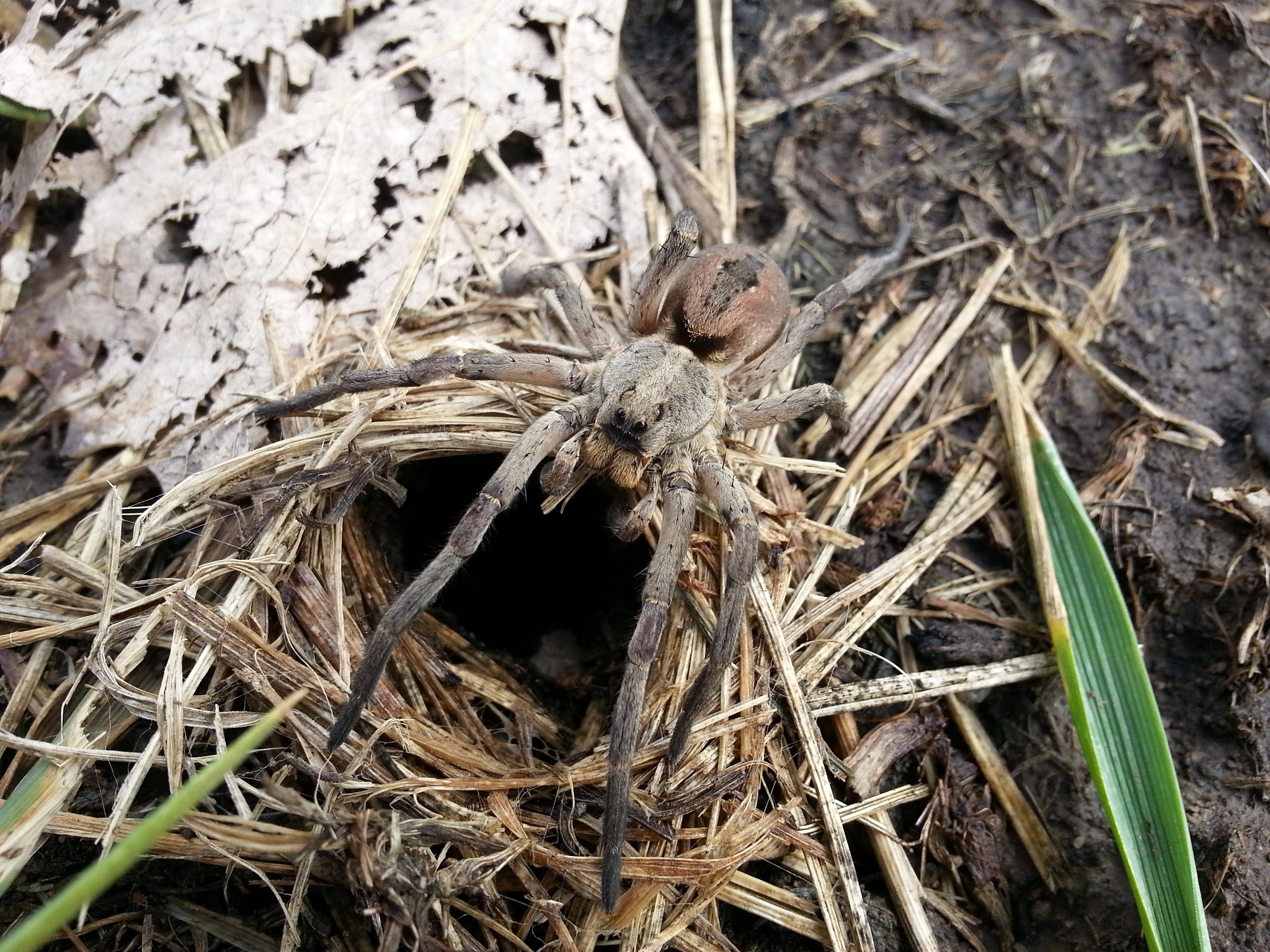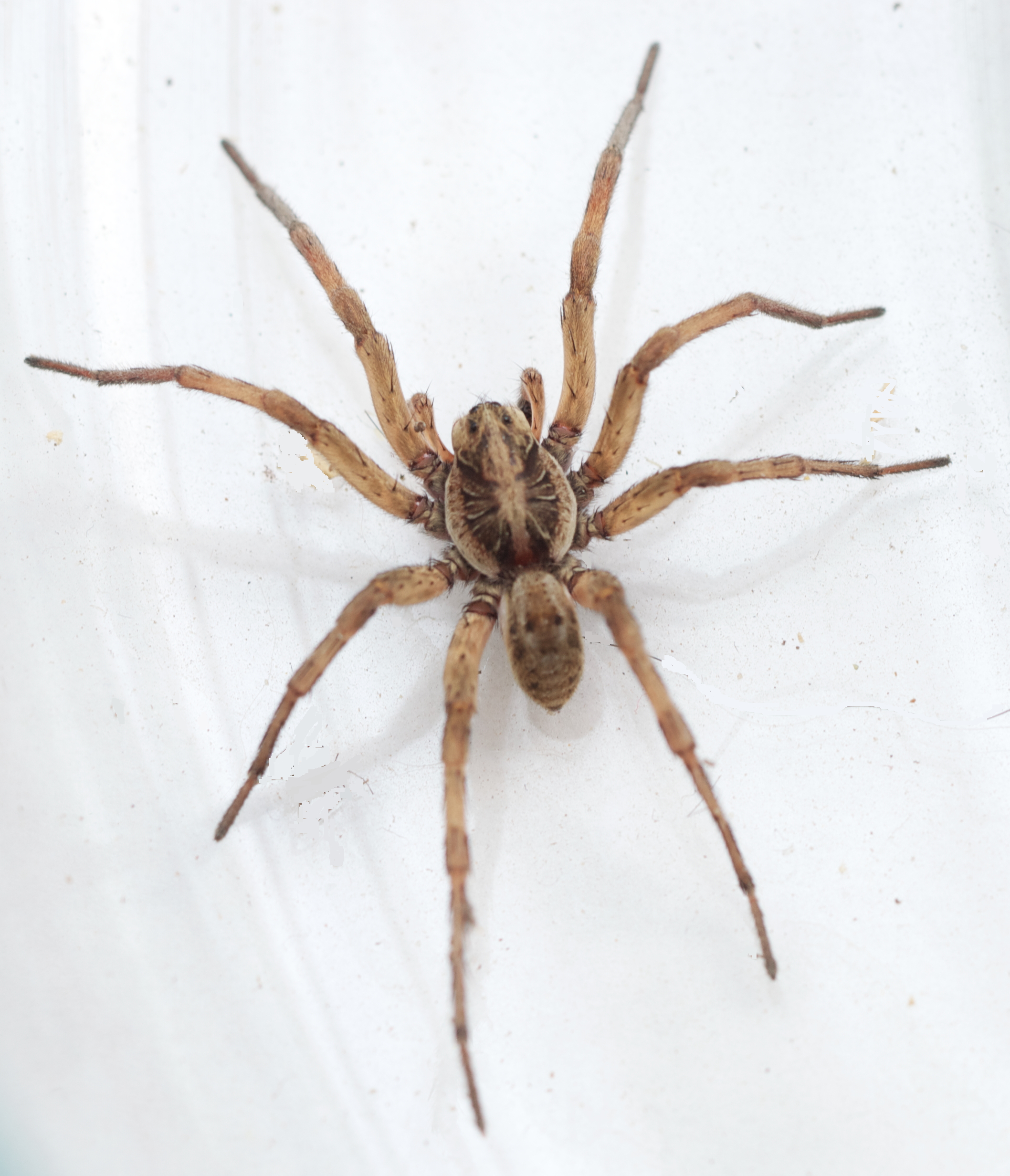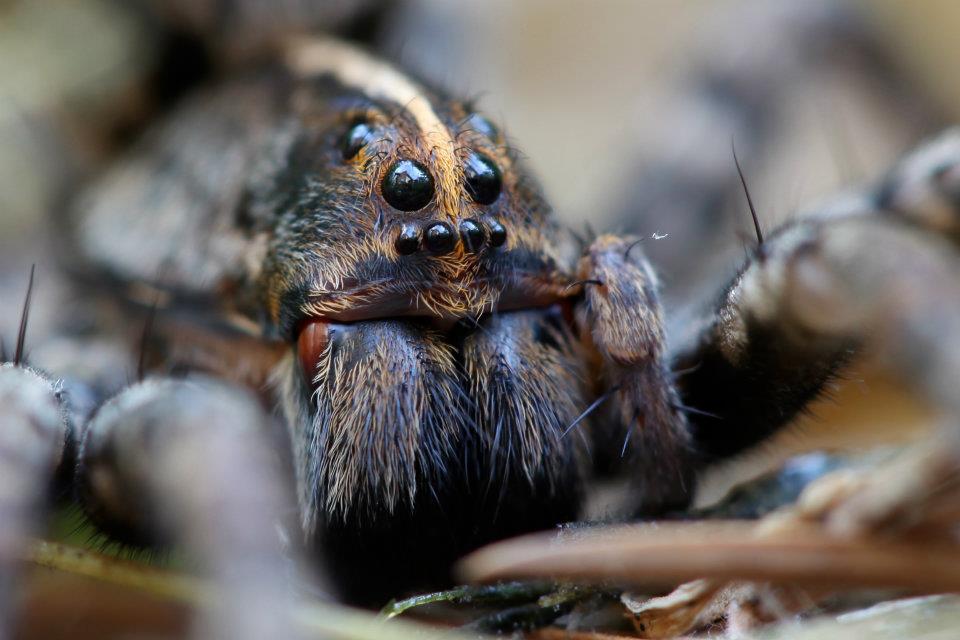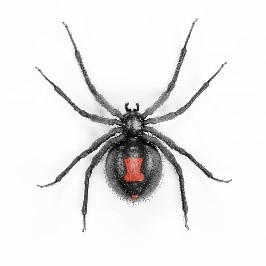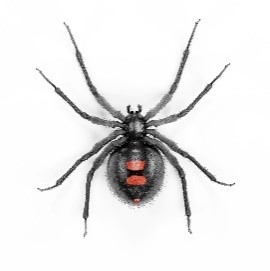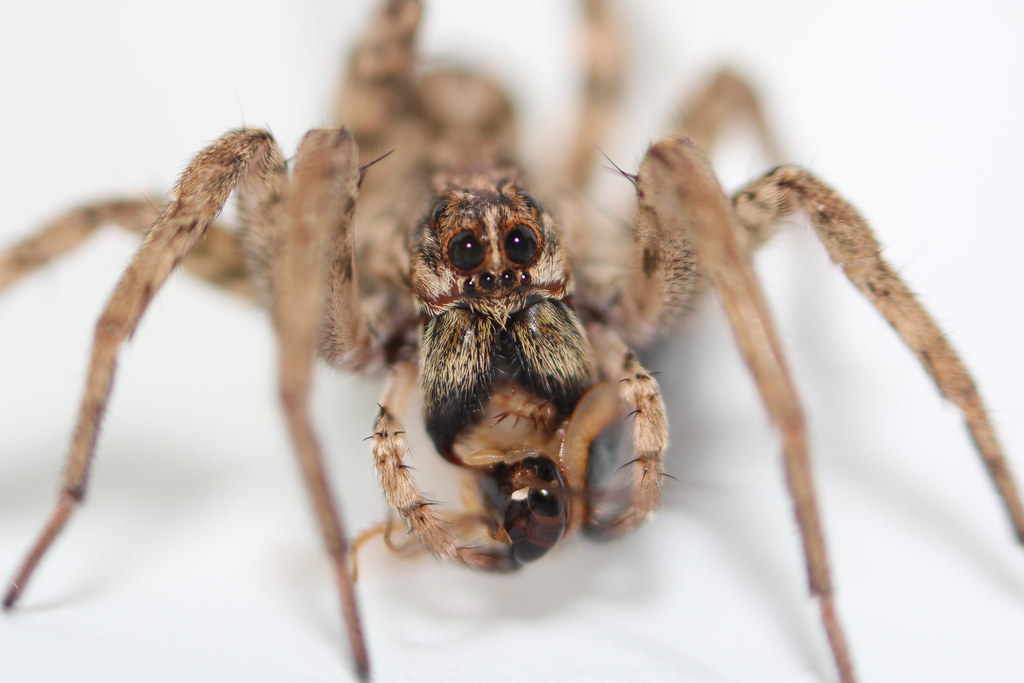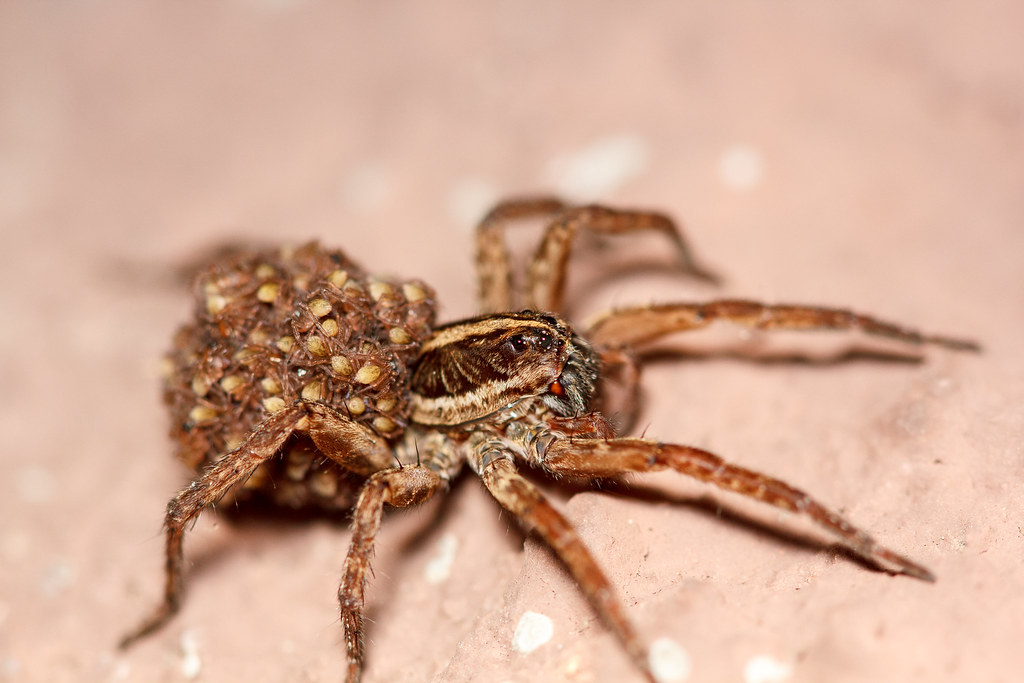Wonders of Wildlife: Carolina Wolf Spider
Carolina Wolf Spider
Other Common Names: Giant Carolina wolf spider
Scientific Name: Hogna carolinensis
Found in Alabama: Statewide
Diet: Carnivore (eats animals) |
|
Carolina Wolf Spider in Habitat
Bugguide.net - Chao "Jimmy" Wu
Click image to enlarge it |
Learn more about...
| CLASSIFICATION |
|
What type of animal am I?
- I am an invertebrate (an animal without a spine or backbone).
- I am cold-blooded, so I cannot control my body temperature.
- I have an exoskeleton (stiff covering) on the outside of my body.
- I breathe through small holes in my abdomen called spiracles and through small openings in the abdomen called book lungs.
- I have eight legs.
|
Scientists use basic traits to group animals into different taxonomic classes.
For a taxonomic classification chart comparing key traits of common backyard wildlife,
CLICK HERE! |
|
| The Carolina Wolf Spider is an ARACHNID! |
| IDENTIFICATION TIPS |
| |
|
| |
|
Carolina Wolf Spider
Wikimedia - Patrick Edwin Moran
Click on image to enlarge it |
ADULT SPIDER |
|
|
- Grayish brown with dark stripe on center of abdomen (hind body segment)
|
|
|
| |
|
Carolina Wolf Spider Face
Gregory Glasscock
Click on image to enlarge it |
- Eight dark eyes arranged in three rows (top two eyes are medium sized, two eyes in middle are larger, and bottom four eyes are small)
|
| |
|
| Alabama's Spiders |
| |
- Alabama is home to over 500 species of spiders.
- Only three of these can be dangerous if they bite you.
|
|
|
|
|
Southern Black Widow
- Black with red hourglass shape on its abdomen or back
|
Northern Black Widow
- Black with "broken" red hourglass shape on its abdomen or back
|
Brown Recluse
- Light brown with long, thin legs
|
| ADAPTATIONS |
| |
| PHYSICAL ADAPTATIONS |
| |
| Carolina wolf spiders avoid detection: |
- The drab gray-brown coloration of the Carolina wolf spider helps it camouflage (blend in with its surroundings).
- This camouflage makes it easiter to avoid being seen by a predator (an animal that eats them).
- They are also extrememly sensitive to vibrations in the ground, allowing them to detect if a threat is nearby which gives them an opportunity to escape into a burrow.
|
| |
| Carolina wolf spiders are excellent hunters: |
- Carolina wolf spiders do not use a web to capture their prey.
- Instead, they have several adaptations that allow them to easily chase down prey.
- They rely on quick speed and excellent eyesight to help them capture their prey.
- They also use their pedipalps (small front legs) to catch their prey.
|
Carolina Wolf Spider Eating Roach
Flickr - StevenW12339
Click on image to enlarge it
|
| |
| BEHAVIORAL ADAPTATIONS |
| |
| Carolina wolf spiders are nocturnal: |
- They are active during the night (nocturnal).
|
| |
| Carolina wolf spiders provide parental care to their offspring: |
- Female Carolina wolf spiders carry their egg sac around with them at all times.
- When the young are ready to hatch, the mother assists in the process.
- The babies crawl on to the female's back and remain with her for about a week until they are ready to provide for themselves.
|
| |
| LIFE CYCLE |
| |
|
|
| Life Cycle Stages of the Carolina Wolf Spider |
| |
|
|
Egg: |
- Females make a silk mat on the ground where she deposits 90-190 soft-shelled eggs (average ove 150 eggs).
- She attaches the silk sac to her abdomen and carries the eggs around with her.
|
| |
|
|
Young: |
- After hatching, the young climb on to the mother’s back where they will stay for around 11-14 days until they are able to hunt on their own.
- Young look similar to the adults.
|
Carolina Wolf Spider Carrying Babies
Flickr - p.sparrow
Click on image to enlarge it |
| |
|
|
Life Span: |
- Females can live up to three years.
- Males do not live as long and may only live up to a year.
|
| |
|
|
NATURAL
Habitat Needs |
ADULTS |
YOUNG |
| Food |
- Carolina wolf spiders are carniovres (eat animals).
- They feed on ground-dwelling insects including beetles, grasshoppers, cockroaches, and other spiders.
|
- The young remain on mother’s back and rely on stored fat until they are able to hunt on their own (up to two weeks after hatching).
|
| Water |
- Hydration is obtained through the animals they eat.
- They will collect water from plants that hold moisture such as mosses.
|
| Shelter |
- They create burrows in open areas in a variety of habitats including fields, meadows, and forests.
- They are likely to take shelter under a rock during the day.
|
- The young remain on mother’s back for up to two weeks until they are able to move around on their own.
|
| Places to Raise Young |
- Females use a small patch of soil on which they construct a silk mat where she will lay her eggs.
- She then carries the eggs and eventually babies on her body until they are independent.
|
|
BACKYARD
Habitat Needs |
ADULTS |
YOUNG |
| Food |
- Provide open grassy areas to support ground-dwelling insects.
- Do not remove decaying logs.
- Plant native plants, shrubs, and trees.
- Do not spray pesticides that might harm insect populations.
|
- Providing food for adults indirectly supports the young.
|
| Water |
- Provide plants that hold moisture such as mosses.
|
| Shelter |
- Provide open grassy areas and some rocks to offer opportunities for burrows and places to hide during the day.
|
- Providing shelter for adults indirectly supports the young.
|
| Places to Raise Young |
- Provide suitable habitat and shelter (see above), as females carry their eggs and young with them.
|
|
| ECOLOGICAL ROLE |
| |
|
| Animals play an important ecological role in the health of habitats and ecosystems. |
| |
|
Food Source: |
- Carolina wolf spiders are a food source for a variety of animals including other spiders, wasps, birds, reptiles, and amphibians.
|
| |
|
Insect Population Control: |
- Because wolf spiders are effective hunters and can be numerous in a given area, they help control populations of the ground-dwelling insects on which they feed.
|
INFORMATION SOURCES FOR THIS SPECIES
.



 Wildlife Tag
Wildlife Tag
